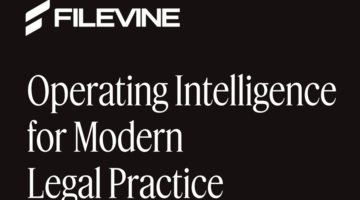 Let’s face it — the billable hour has been discussed for decades. Now, in light of the hype about Generative AI, many believe the legal industry will shift toward flat rates and alternate fee arrangements.
Let’s face it — the billable hour has been discussed for decades. Now, in light of the hype about Generative AI, many believe the legal industry will shift toward flat rates and alternate fee arrangements.
What will Generative AI do to the billable hour?
- Rates will go up.
- Rates will go down.
- Work will shift to alternate fee arrangements.
- Work will go in-house.
- All of the above.

How Filevine’s New DraftAI Cuts Out Hours Of Writing Work
Now it transforms your document creation with natural language prompts.
I choose all of the above.
I believe all the answers are right. Your own answer may be influenced by different factors like market segment, practice area, the type of work product, and the client. The best way to describe the reason for such a lively discussion is because the conversation is similar to the parable of the blind men describing an elephant. In the story, one person feels the trunk of the elephant and thought the elephant was a snake. Another feels the tusk, and yet another feels one of the elephant’s legs, and each individual draws their own conclusion based on what they experience. All are partially correct but don’t perceive the entire elephant.
So it is with AI and the billable hour. The answer to the question of the billable hour may be very different if we are talking about the merger of two multinational pharmaceutical companies versus a lawyer navigating the closing process for a commercial real estate transaction in Nebraska.
Here are some arguments for each of the answers to the multiple-choice question about AI and the billable hour.

Why Your Practice Is Burning Money And How You Can Do Better
Our expert panel explores common sources of profit leakage along with practical steps for improvement.
Rates Will Go Up
Remember when law firms passed the cost of legal research services and the time associates spent conducting general research back to their clients? Twenty-five years ago, legal research costs were even marked up to cover administrative overhead associated with the research services used. Some law firms and clients were so insensitive to the cost of legal research services that they welcomed the rate increases from legal research providers as they were passed through to clients with a mark-up.
That was before the days of spend and matter management solutions. When law firms were no longer able to charge for general legal research services or the cost of vendors, what happened?
These days, sophisticated clients enforce strict rules on what is billable and what is not. But back then, the costs were likely passed along to the client in some other manner to preserve margins and profitability. The increase in nonbillable activities has likely contributed to the long-term trend of higher hourly rates from attorneys.
For high-value legal work that addresses bespoke issues, rates will likely go up when AI efficiencies are achieved.
The value and outcome to the client will remain unchanged or will increase; that point is key. If AI contributes to the efficiency of the work, but the value of the outcomes remains high, then the costs in the form of billable hours will likely go up, even if the savings are shared by the client and the firm. A good example of this kind of work is bet-the-company litigation or other high-stakes controversies.
Rates Will Go Down
On the other hand, rates will likely go down for other kinds of work. Technology has commoditized other legal services, such as certain aspects of discovery. Competition in the form of alternative legal service providers (ALSPs) has seen significant growth. When AI is applied to more repeatable legal services where there are options for how the work can be completed, the economics of supply and demand will kick in and competition will force rates down. Look for rates to go down on work that can be accomplished using ALSPs — and look for ALSPs to expand into new areas where AI creates more predictable estimations of high-volume, repetitive work.
Work Will Shift To Alternate Fee Arrangements
Alternate fee arrangements, including fixed fees for certain work, have been around for a long time. The more predictable the work, the more likely an alternate fee approach is viable. This is the case with or without the benefit of AI.
As AI creates more automation for tasks that were less predictable, fixed fees will become more common. A firm’s labor and employment practice may be able to charge fixed fees for work like reviewing an executive compensation agreement or for responding to an EEOC complaint.
For a firm that focuses on litigating insurance claims for automobile accidents on behalf of a large insurance company, fixed fee arrangements can become even more predictable. A firm that knows its cost structure can more effectively bid on 100 cases knowing that on average, they can be competitive and be profitable.
Work Will Go In-House
Repeatable work will go in-house when client know-how and client data is a critical part of the process. Said another way, when outside expertise is not an important ingredient, work is best done by in-house counsel and can be automated using client systems.
Closing Thoughts
When I was a consultant in another industry, the way we price fixed-bid projects was to understand the client’s budget, and then we estimated the project based upon the hours and rates. If the customer wanted a fixed bid, we would add 20% to ensure that cost over-runs or poor estimations didn’t burn us. And if our estimate was well below the budget, it provided freedom to be more liberal in how we estimated the effort.
In short, fixed-rate matters are desirable to clients, but will be priced higher than hourly-based matters because fixed-rate matters shift more risk to the law firm for overruns. This is one of the biggest reasons I believe the billable hour won’t go away entirely in the foreseeable future.
One thing is for sure: as AI helps automate and make work more predictable, both law firms and clients will benefit. Clients can more effectively budget for expenses related to work. And firms can leverage technology for more consistent work product and more predictable estimates.
Let’s look toward a future where work is completed in-house as appropriate and where the expertise of law firms is valued. And let’s look forward to a future where legal work is more predictable and efficient for all parties regardless of whether the work is billed by the hour or through an alternate fee arrangement.
 Ken Crutchfield is Vice President and General Manager of Legal Markets at Wolters Kluwer Legal & Regulatory U.S., a leading provider of information, business intelligence, regulatory and legal workflow solutions. Ken has more than three decades of experience as a leader in information and software solutions across industries. He can be reached at [email protected].
Ken Crutchfield is Vice President and General Manager of Legal Markets at Wolters Kluwer Legal & Regulatory U.S., a leading provider of information, business intelligence, regulatory and legal workflow solutions. Ken has more than three decades of experience as a leader in information and software solutions across industries. He can be reached at [email protected].